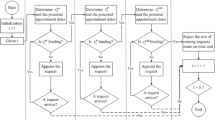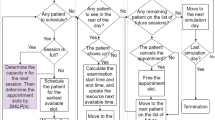Abstract
When faced with a medical problem, patients contact their primary care physician (PCP) first. Here mainly two types of patient requests occur: non-scheduled patients who are walk-ins without an appointment and scheduled patients with an appointment. Number and position of the scheduled appointments influence waiting times for patients, capacity for treatment and the utilization of PCPs. As the number of patient requests differs significantly between weekdays, the challenge is to match capacity with patient requests and provide as few appointment slots as necessary. In this way, capacity for walk-ins is maximized while overall capacity restrictions are met. Decisions as to the optimal appointment capacity per day on a tactical decision level has gained little attention in the literature. A mixed integer linear model is developed, where the minimum number of appointments scheduled for a weekly profile is determined. We are thus able to give the answer as to how many appointments to offer on each day in a week in order to create a schedule that takes patient preferences as well as PCP preferences into account. Appointment schedules are often influenced by uncertain demands due to the number of urgent patients, interarrivals and service times. Based on an exemplary case study, the advantages of the optimal appointment schedule on different performance criteria are shown by detailed stochastic simulations.








Similar content being viewed by others
References
Balasubramanian H, Biehl S, Dai L, Muriel A (2014) Dynamic allocation of same-day requests in multi-physician primary care practices in the presence of prescheduled appointments. Health Care Manag Sci 17(1):31–48
Balasubramanian H, Muriel A, Ozen A, Wang L, Gao X, Hippchen J (2013) Capacity allocation and flexibility in primary care. In: Denton BT (ed) Handbook of healthcare operations management, volume 184 of International Series in Operations Research and Management Science, pp 205–228
Brailsford S, Kozan E, Rauner MS (2012) Health care management. Flex Serv Manuf J SI 24(4):375–378
Cao W, Yi W, Haibo T, Shang F, Liu D, Tan Z, Sun C, Ye Q, Xu Y (2011) A web-based appointment system to reduce waiting for outpatients: A retrospective study. BMC Health Serv Res:11
Cayirli T, Veral E (2003) Outpatient scheduling in health care: a review of literature. Prod Oper Manag 12(4):519–549
Cayirli T, Veral E, Rosen H (2006) Designing appointment scheduling systems for ambulatory care services. Health Care Manag Sci 9(1):47–58
Degel D, Wiesche L, Rachuba S, Werners B (2014) Time-dependent ambulance allocation considering data-driven empirically required coverage. Health Care Manag Sci:1–15
Dobson G, Hasija S, Pinker EJ (2011) Reserving capacity for urgent patients in primary care. Prod Oper Manag 20(3):456–473
Feldman J, Topaloglu NLH, Ziya S (2014) Appointment scheduling under patient preference and no-show behavior. Oper Res 62(4):794–811
Fico Xpress-optimizer referenz manual. Fico Xpress Optimization Suite (www.fico.com), Release 20.00, 3 June 2009
Gallucci G, Swartz W, Hackerman F (2005) Brief reports: impact of the wait for an initial appointment on the rate of kept appointments at a mental health center. Psychiatr Serv 56(3):344–346
Gupta D, Denton B (2008) Appointment scheduling in health care: challenges and opportunities. IIE Trans 40(9):800–819
Harper P, Gamlin HM (2003) Reduced outpatient waiting times with improved appointment scheduling: a simulation modelling approach. OR Spectrum 25(2):207–222
Klassen KJ, Rohleder TR (1996) Scheduling outpatient appointments in a dynamic environment. J Oper Manag 14(2):83–101
Klassen KJ, Rohleder TR (2004) Outpatient appointment scheduling with urgent clients in a dynamic, multi-period environment. Int J Serv Ind Manag 15(2):167–186
Krueger U, Schimmelpfeng K (2013) Characteristics of service requests and service processes of fire and rescue service dispatch centres. Health Care Manag Sci 16:1–13
LaGanga L, Lawrence S (2007) Clinic overbooking to improve patient access and increase provider productivity. Decis Sci 38(2):251–276
Lanner Witness simulation tool. Power with Ease Release 1.0, Witness (www.lannersimtech.de), June 2009
Liu N, Ziya S, Kulkarni VG (2010) Dynamic scheduling of outpatient appointments under patient no-shows and cancellations. M&SOM-Manufacturing & Service Operations Management 12(2):347–364
Murray Mark, Berwick DM (2003) Advanced access: reducing waiting and delays in primary care. JAMA 289(8):1035– 1040
Ozen A, Balasubramanian H (2013) The impact of case mix on timely access to appointments in a primary care group practice. Health Care Manag Sci 16(2):101–118
Xiuli Q, Rardin RL, Williams JAS, Willis DR (2007) Matching daily healthcare provider capacity to demand in advanced access scheduling systems. Eur J Oper Res 183(2):812– 826
Rachuba S, Werners B (2015) A fuzzy multi-criteria approach for robust operating room schedules. Ann Oper Res:1–26
Rising EJ, Baron R, Averill B (1973) A systems analysis of a university-health-service outpatient clinic. Oper Res 21(5):1030–1047
Robinson LW, Chen RR (2010) A comparison of traditional and open-access policies for appointment scheduling. M&SOM-Manufacturing & Service Operations Management 12(2):330–346
Rohleder TR, Klassen KJ (2000) Using client-variance information to improve dynamic appointment scheduling performance. Omega 28(3):293–302
Rohleder TR, Klassen KJ (2002) Rolling horizon appointment scheduling: a simulation study. Health Care Manag Sci 5(3):201–209
Schacht M, Wiesche L, Werners B, Weltermann B (2015) Influence of appointment times on interday scheduling. In: Operations Research Proceedings 2015, accepted for publication
De Vuyst S, Bruneel H, Fiems D (2014) Computationally efficient evaluation of appointment schedules in health care. Eur J Oper Res 237(3):1142–1154
Acknowledgments
The authors gratefully acknowledge the helpful comments of the associate editor and referees. Thanks are also due to Priv.-Doz. Dr. med. Birgitta Weltermann, Institut für Allgemeinmedizin, Universiätsklinikum, Essen, Germany, for providing valuable insights into medical practice.
Author information
Authors and Affiliations
Corresponding author
Rights and permissions
About this article
Cite this article
Wiesche, L., Schacht, M. & Werners, B. Strategies for interday appointment scheduling in primary care. Health Care Manag Sci 20, 403–418 (2017). https://doi.org/10.1007/s10729-016-9361-7
Received:
Accepted:
Published:
Issue Date:
DOI: https://doi.org/10.1007/s10729-016-9361-7




